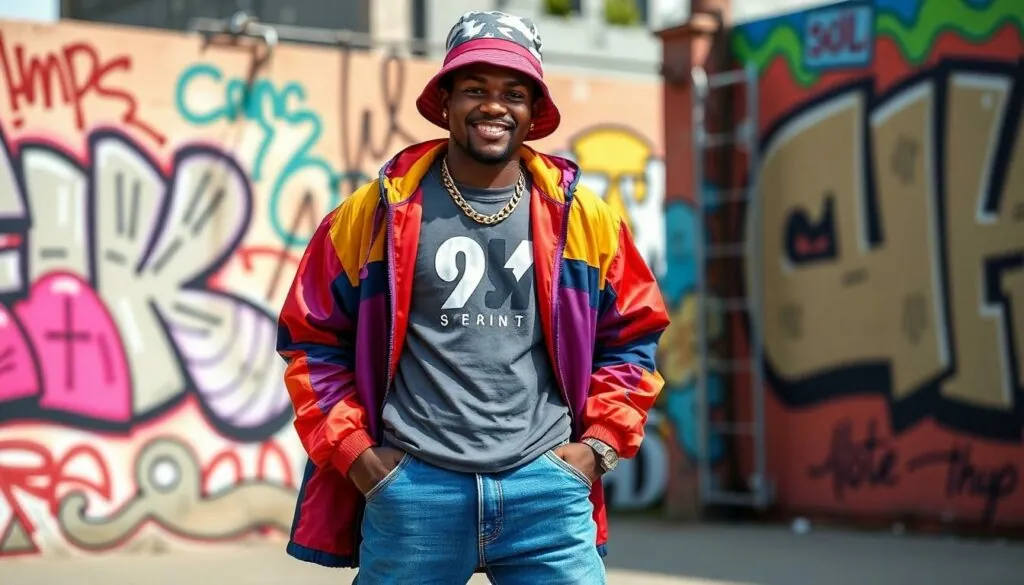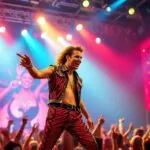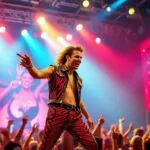Table of Contents
ToggleIn the vibrant world of the 90s, hip hop fashion for men was more than just clothing; it was a bold statement. Picture oversized jeans hanging low, colorful windbreakers that could double as parachutes, and enough bling to make a disco ball jealous. This era wasn’t just about style; it was a cultural revolution that redefined masculinity and self-expression.
From baggy pants to bucket hats, the 90s served up a buffet of fashion choices that still influence trends today. Whether he was rocking a fresh pair of Air Jordans or a graphic tee featuring his favorite rapper, every outfit told a story. So grab your snapback and get ready to dive into the iconic world of 90s hip hop fashion, where every stitch was a nod to creativity and rebellion.
Overview of 90s Hip Hop Fashion Male
90s hip hop fashion for men emerged as a distinctive style that mirrored the cultural ethos of the time. Key elements included baggy jeans, vibrant graphic tees, and oversized jackets that provided both comfort and flair. Windbreakers showcased bold colors and patterns, becoming staples in many wardrobes.
Accessories played a crucial role in completing outfits. Baseball caps, bucket hats, and gold chains added personality and often represented individual stories or backgrounds. Sneakers, particularly high-tops and limited editions, not only served as footwear but also as status symbols.
Style choices conveyed messages about identity and artistry. For instance, artists like Biggie Smalls and Tupac Shakur influenced trends with their signature looks. Wearing oversized clothing not only defied conventional fashion norms but also made statements about self-worth and freedom.
Brands like FUBU, Tommy Hilfiger, and Polo Ralph Lauren gained significant traction, linking hip hop culture to mainstream fashion. Urban streetwear became increasingly popular and blurred the boundaries between luxury and everyday wear. Each outfit became an expression of creativity, with individuals mixing and matching pieces for a personal touch.
The legacy of 90s hip hop fashion remains alive in today’s styles. Contemporary trends often borrow from this vibrant era, showcasing the lasting impact of oversized silhouettes and bold graphics. Fashion from the 90s continues to inspire and resonate, ensuring that its cultural significance won’t fade away.
Key Trends in 90s Hip Hop Fashion

90s hip hop fashion for men featured distinct trends that became symbols of the era’s culture and creativity.
Baggy Clothing Styles
Baggy clothing dominated 90s hip hop fashion. Oversized jeans provided both comfort and a relaxed style, often worn low on the hips. Baggy cargo pants became popular, offering extra pockets and functionality. Shirts were typically loose-fitting, with many artists opting for large sizes to enhance their laid-back aesthetic. Styles highlighted individuality while often serving as a commentary on societal norms. The influence of artists such as Notorious B.I.G. and Wu-Tang Clan helped popularize these baggier silhouettes, defining a relaxed yet bold statement of self-expression.
Graphic Tees and Streetwear
Graphic tees featured prominently in 90s hip hop fashion. Bold artwork and vibrant colors made these shirts eye-catching and expressive. Many graphics showcased references to popular culture, music, or political messages. Streetwear brands emerged during this era, blending casual wear with high fashion influences. Many men sported oversized tees paired with layered looks, creating a unique street style. Popular brands like FUBU and Stüssy offered items that resonated with hip hop’s rebellious spirit, further solidifying the genre’s connection to fashion.
Sneakers and Footwear
Sneakers served as critical elements in 90s hip hop fashion. High-tops gained popularity due to their association with sports and street culture. Brands such as Nike, Adidas, and Reebok released limited editions, turning footwear into status symbols. Iconic models like Air Jordans became essential for self-expression within the hip hop community. Many men coordinated their outfits to match their sneaker choices, elevating their overall look. Footwear played a significant role in challenging fashion boundaries while reflecting personal style.
Influential Figures in 90s Hip Hop Fashion
90s hip hop fashion gained momentum through the unique styles of various influential figures. Iconic rappers played a significant role in shaping trends and setting standards that defined the decade.
Iconic Rappers and Their Styles
Artists like Biggie Smalls used oversized clothing to express individuality. His signature look included baggy suits, shades, and polished shoes. Tupac Shakur combined street style with elements of elegance, showcasing leather jackets and denim. Nas influenced fashion through his casual yet stylish choices, featuring graphic tees and distressed jeans. Each rapper created a distinct persona that resonated with fans and reflected broader cultural movements.
Impact of Celebrity Endorsements
Celebrity endorsements played a crucial role in popularizing brands within hip hop fashion. Influential figures often collaborated with companies to create exclusive lines that resonated with their audience. For instance, brands like FUBU capitalized on partnerships with prominent rappers, linking their image to hip hop culture. Tommy Hilfiger and Polo Ralph Lauren witnessed unprecedented sales growth as celebrities donned their apparel, effectively bridging hip hop with mainstream fashion. This synergy established a lasting impact on consumer preferences, as fans sought to emulate their favorite artists’ styles.
Cultural Significance of 90s Hip Hop Fashion
90s hip hop fashion represents a pivotal moment in cultural expression where music, style, and identity intertwined.
Connection to Music and Identity
Music served as a powerful backdrop for 90s hip hop fashion. Rappers like Biggie Smalls and Tupac Shakur influenced style choices through their lyrics and public personas. Fashion became a tool for self-expression, allowing artists to project their backgrounds boldly. Each outfit reflected individual stories and cultural nuances, creating a unique identity in the hip hop community. Clothing choices often mirrored the lyrics, merging personal history with broader societal commentary. Baggy jeans and oversized jackets symbolized rebellion, resonating with the struggles faced in urban spaces. Ultimately, this relationship between music and fashion laid the groundwork for future generations to express themselves authentically.
Influence on Modern Fashion Trends
Modern fashion continues to draw inspiration from the 90s hip hop era. Current designers often revisit oversized silhouettes and graphic tees, reflecting the past while creating fresh looks. Brands like Off-White and Yeezy incorporate streetwear elements, highlighting the lasting impact of that vibrant time. Many contemporary celebrities adopt 90s-inspired styles, linking nostalgia with cutting-edge fashion. Sneakers remain a key focus, with retro models from brands like Nike and Adidas gaining popularity. Styles that once belonged to the hip hop culture now permeate mainstream fashion, reinforcing the importance of this influential decade. The blending of casual and luxury wear highlights how 90s aesthetics remain relevant today.
The legacy of 90s hip hop fashion for men remains a powerful influence in today’s style landscape. Its unique blend of comfort and self-expression paved the way for future trends that continue to resonate with contemporary audiences. The era’s iconic elements like oversized silhouettes and bold graphics have not only shaped individual identities but also revolutionized the fashion industry.
As modern designers draw inspiration from this vibrant decade, the connection between music and fashion remains strong. The ongoing popularity of retro styles and sneaker culture reflects a deep appreciation for the creativity and cultural significance that defined 90s hip hop fashion. This movement has undoubtedly left an indelible mark on how people express themselves through clothing, ensuring its relevance for generations to come.





